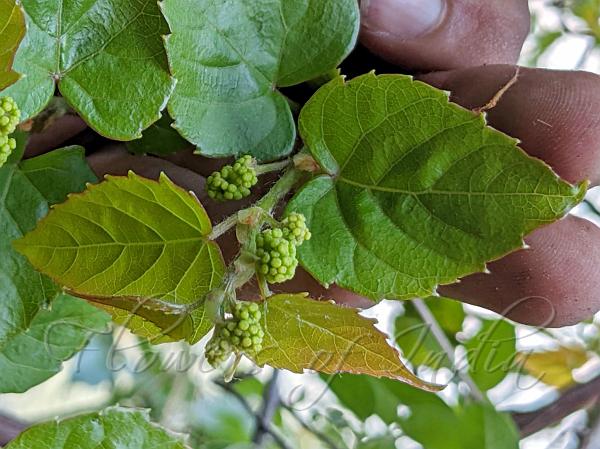|
| Oriental Grape |
|

|

| File size | 636143 |
| Original date | 5/9/22 7:59 PM |
| Resolution | x |
| Flash | Flash did not fire, auto |
| Focal length | 4.38mm |
| Exposure time | 1/357s |
| Aperture | 1.73 |
| Focus Distance | |
| Metering Mode | $meteringMode |
| Camera make | |
| Camera model | Pixel 5a |
| Sensor type |
|
|
|
|
Photo: |
Botanical name: Vitis flexuosa Family: Vitaceae (Grape family)
Synonyms: Vitis parvifolia, Vitis cinerea, Vitis truncata, Vitis wallichii
Synonyms: Vitis parvifolia, Vitis cinerea, Vitis truncata, Vitis wallichii
Oriental Grape is a woody climber with branches long
and thin, branchlet sparsely covered with greyish white arachnoid
tomentums before maturity. Tendrils are opposite to leaf, dichotomous
branching. Leaves are ovate, broad ovate, triangular ovate or ovate
elliptic, 2.5-12 cm long, tip suddenly sharpens or gradually sharpens,
basal part shallow heart-shaped or nearly flat, each margin with 5-12
slightly irregular sawtooth, downside sparsely covered with arachnoid
tomentums before maturity, netveined vein indistinct, basal veins 5;
leaf-stalk 1.5-7cm long, sparsely covered with arachnoid tomentums or
almost hairless. Flowers are borne in sparse panicles, basal branch
developed, 4-12 cm long, flower-cluster-stalk 2-5 cm long, covered with
arachnoid tomentums or almost hairless. Sepal-cup is shallow
pea-shaped, margin with sinuate shallow lobes; petals exhibit cap like
bonding that falls off later; hermaphrodite flower with a short stigma;
flower disc with 5 lobes; ovary round ovate, stamen equal to ovary in
length. Fruit is spherical, 0.8-1 cm in diameter, purplish black when
mature. Oriental Grape is found in forests, shrublands, hillsides,
valleys, meadows, fields, at altitudes of 100-2300 m, in the Himalayas,
from Nepal to S China, Korea and Japan, Flowering: March-May.
Medicinal uses: Juice is used for fatigue,
hydrodipsia, hiccups, injuries caused by falls. Fruits are used for
xeropulmonary cough, hematemesis, dyspepsia, dysentery. Leaves are used
for food accumulation, dysentery, eczema, scalding and burns. Root or
root bark is used for icteric hepatitis, rheumatic arthralgia, injuries
caused by falls, and anthracia.
Juice is used for fatigue,
hydrodipsia, hiccups, injuries caused by falls. Fruits are used for
xeropulmonary cough, hematemesis, dyspepsia, dysentery. Leaves are used
for food accumulation, dysentery, eczema, scalding and burns. Root or
root bark is used for icteric hepatitis, rheumatic arthralgia, injuries
caused by falls, and anthracia.
Medicinal uses:
 Juice is used for fatigue,
hydrodipsia, hiccups, injuries caused by falls. Fruits are used for
xeropulmonary cough, hematemesis, dyspepsia, dysentery. Leaves are used
for food accumulation, dysentery, eczema, scalding and burns. Root or
root bark is used for icteric hepatitis, rheumatic arthralgia, injuries
caused by falls, and anthracia.
Juice is used for fatigue,
hydrodipsia, hiccups, injuries caused by falls. Fruits are used for
xeropulmonary cough, hematemesis, dyspepsia, dysentery. Leaves are used
for food accumulation, dysentery, eczema, scalding and burns. Root or
root bark is used for icteric hepatitis, rheumatic arthralgia, injuries
caused by falls, and anthracia. | Identification credit: Ashutosh Sharma | Photographed in Khokhan WLS, Kullu district, Himachal Pradesh. |
• Is this flower misidentified? If yes,